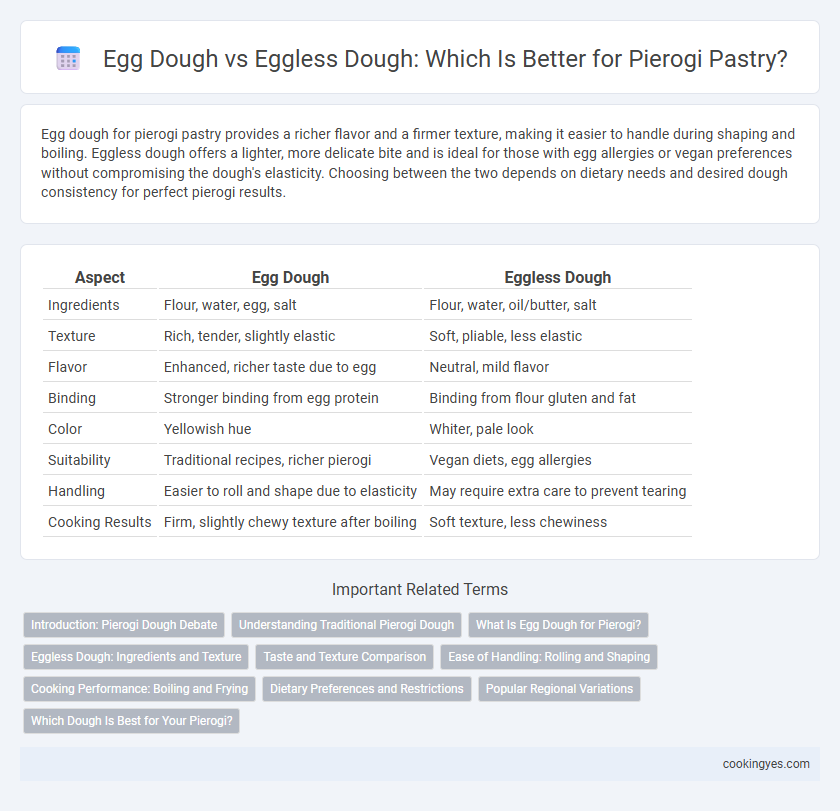Egg dough for pierogi pastry provides a richer flavor and a firmer texture, making it easier to handle during shaping and boiling. Eggless dough offers a lighter, more delicate bite and is ideal for those with egg allergies or vegan preferences without compromising the dough's elasticity. Choosing between the two depends on dietary needs and desired dough consistency for perfect pierogi results.
Table of Comparison
| Aspect | Egg Dough | Eggless Dough |
|---|---|---|
| Ingredients | Flour, water, egg, salt | Flour, water, oil/butter, salt |
| Texture | Rich, tender, slightly elastic | Soft, pliable, less elastic |
| Flavor | Enhanced, richer taste due to egg | Neutral, mild flavor |
| Binding | Stronger binding from egg protein | Binding from flour gluten and fat |
| Color | Yellowish hue | Whiter, pale look |
| Suitability | Traditional recipes, richer pierogi | Vegan diets, egg allergies |
| Handling | Easier to roll and shape due to elasticity | May require extra care to prevent tearing |
| Cooking Results | Firm, slightly chewy texture after boiling | Soft texture, less chewiness |
Introduction: Pierogi Dough Debate
Egg dough for pierogi pastry offers a richer texture and a slightly firmer bite due to the protein structure eggs provide, enhancing elasticity and flavor depth. Eggless dough variants prioritize a lighter, more delicate consistency, appealing to vegan diets or those with egg allergies while maintaining pliability through alternative binding agents like flour and water ratios. Nutritional differences arise as egg dough contributes additional fats and proteins, whereas eggless recipes tend to be lower in cholesterol and fat content.
Understanding Traditional Pierogi Dough
Traditional pierogi dough often varies between egg dough and eggless dough, each impacting texture and elasticity significantly. Egg dough, richer in protein and fat, offers a tender yet sturdy pastry ideal for holding diverse fillings without tearing. Eggless dough, commonly preferred in vegan or allergy-sensitive diets, yields a chewier texture and relies on proper flour-to-water ratios to achieve the necessary pliability for perfect pierogi formation.
What Is Egg Dough for Pierogi?
Egg dough for pierogi consists of flour, water, and eggs, which contribute to a richer texture and slightly firmer pastry compared to eggless dough. The inclusion of eggs enhances elasticity, allowing the dough to be rolled thinner and hold fillings more securely during boiling or frying. This traditional egg dough provides a tender yet resilient wrapper that complements a variety of savory or sweet pierogi fillings.
Eggless Dough: Ingredients and Texture
Eggless dough for pierogi typically consists of flour, water, salt, and sometimes a bit of oil or vinegar to enhance elasticity and texture. This dough yields a tender yet slightly chewier pastry compared to egg dough, making it ideal for those seeking a vegan or allergy-friendly option. The absence of eggs results in a lighter, less rich texture, which allows the filling flavors to stand out more prominently.
Taste and Texture Comparison
Egg dough pierogi offers a richer flavor and slightly firmer texture due to the egg's binding properties, enhancing the pastry's elasticity and chewiness. Eggless dough results in a lighter, more delicate taste and a softer, more tender texture, often preferred by those seeking a dairy-free or vegan option. The choice between egg and eggless dough significantly affects the overall mouthfeel and flavor profile of pierogi, with egg dough providing robustness and eggless dough delivering subtlety.
Ease of Handling: Rolling and Shaping
Egg dough for pierogi pastry offers a firmer texture, making it easier to roll out evenly and shape without tearing, which is ideal for delicate fillings. Eggless dough tends to be softer and more elastic, requiring careful handling to prevent sticking and deformation during shaping. Both types benefit from proper flouring of surfaces, but egg dough generally provides superior control and durability during the rolling and shaping process.
Cooking Performance: Boiling and Frying
Egg dough for pierogi offers a firmer texture that holds shape well during boiling and achieves a golden, crispy exterior when fried, enhancing overall cooking performance. Eggless dough tends to be more delicate and may require gentler handling to prevent tearing in boiling water, but it can produce a tender bite with a lighter crust after frying. Choosing between egg and eggless dough depends on desired texture and durability during both boiling and frying preparations.
Dietary Preferences and Restrictions
Egg dough for pierogi offers a richer texture and higher protein content, appealing to those without egg allergies or vegan preferences. Eggless dough caters to dietary restrictions such as veganism, egg allergies, and cholesterol-conscious diets by using alternative binding agents like water, flour, and oil. Choosing between egg and eggless dough depends on balancing taste preferences with health needs and ethical considerations.
Popular Regional Variations
In Polish cuisine, egg dough pierogi are favored for their rich texture and golden color, commonly found in eastern regions like Podlachia, where eggs enhance elasticity and flavor. In contrast, many Ukrainian and Belarusian pierogi recipes use eggless dough to achieve a lighter, more delicate pastry, suited to fillings like sauerkraut or mushrooms. These regional variations reflect local preferences, ingredient availability, and traditional practices, influencing the pierogi's final texture and taste.
Which Dough Is Best for Your Pierogi?
Egg dough for pierogi offers a richer flavor and a slightly firmer texture that holds fillings well during boiling or frying, making it ideal for savory or hearty fillings like potatoes and cheese. Eggless dough, often made with just flour, water, and salt, results in a lighter, more delicate pastry that is perfect for sweet or vegetable-filled pierogi, appealing to vegan diets and those with egg allergies. Choosing the best dough depends on the desired texture and dietary preferences, with egg dough providing robustness and eggless dough ensuring versatility and inclusivity.
Egg dough vs Eggless dough for Pierogi pastry Infographic

 cookingyes.com
cookingyes.com